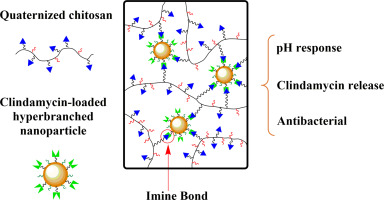当前位置:
X-MOL 学术
›
Int. J. Biol. Macromol.
›
论文详情
Our official English website, www.x-mol.net, welcomes your
feedback! (Note: you will need to create a separate account there.)
Dual-crosslinked nanocomposite hydrogels based on quaternized chitosan and clindamycin-loaded hyperbranched nanoparticles for potential antibacterial applications.
International Journal of Biological Macromolecules ( IF 7.7 ) Pub Date : 2020-03-26 , DOI: 10.1016/j.ijbiomac.2020.03.182 Shibo Wei 1 , Xiang Liu 1 , Junhui Zhou 1 , Jianhua Zhang 1 , Anjie Dong 2 , Pingsheng Huang 3 , Weiwei Wang 3 , Liandong Deng 1
International Journal of Biological Macromolecules ( IF 7.7 ) Pub Date : 2020-03-26 , DOI: 10.1016/j.ijbiomac.2020.03.182 Shibo Wei 1 , Xiang Liu 1 , Junhui Zhou 1 , Jianhua Zhang 1 , Anjie Dong 2 , Pingsheng Huang 3 , Weiwei Wang 3 , Liandong Deng 1
Affiliation

|
Bacterial infections caused by S. aureus are prevalent all over the world. Antibiotic-loaded hydrogel has been reported as a promising drug delivery system for the treatment. However, the direct incorporation of antibiotics into the hydrogel leads to quick initial burst release, which results in a sub-inhibition concentration of antibiotics in local environment and induces the antibiotic resistance of bacteria. In this work, a novel dual-crosslinked nanocomposite hydrogel (imine bond and nanoparticle crosslinking) was prepared based on quaternized chitosan and clindamycin-loaded hyperbranched nanoparticles. Dual-crosslinked nanocomposite structure endowed the hydrogel with considerable mechanical and injectable properties. Dual pH responses were introduced into the hydrogel, and a controlled clindamycin release was observed in the acidic environment, which might avoid inducing the antibiotic resistance of bacteria. What's more, the antibacterial results demonstrated an excellent antibacterial activity of the hydrogel for not only E. coli and S. aureus, but also Methicillin-resistant S. aureus (MRSA). Nearly 90% of bacteria was killed after contacting with the hydrogel. In addition, the in vitro cell cytotoxicity test results showed that the hydrogel owned good biocompatibility. The in vitro cell viability was >90%. Above all, this dual-crosslinked nanocomposite hydrogel owned possibility for potential antibacterial applications.
中文翻译:

基于季铵化壳聚糖和负载克林霉素的超支化纳米粒子的双交联纳米复合水凝胶,可用于潜在的抗菌应用。
金黄色葡萄球菌引起的细菌感染在世界各地普遍存在。据报道载有抗生素的水凝胶是一种有前途的药物治疗系统。但是,将抗生素直接掺入水凝胶会导致快速的初始突释释放,从而导致局部环境中的抗生素亚抑制浓度降低,并引起细菌的抗生素抗性。在这项工作中,基于季铵化壳聚糖和负载克林霉素的超支化纳米粒子,制备了一种新型的双交联纳米复合水凝胶(亚胺键和纳米粒子交联)。双交联的纳米复合材料结构赋予水凝胶相当大的机械和可注射特性。将双重pH响应引入水凝胶,在酸性环境中观察到了克林霉素的可控释放,可以避免诱导细菌的抗生素耐药性。此外,抗菌结果表明水凝胶不仅对大肠杆菌和金黄色葡萄球菌,而且对耐甲氧西林的金黄色葡萄球菌(MRSA)都具有出色的抗菌活性。与水凝胶接触后,将近90%的细菌被杀死。此外,体外细胞毒性试验结果表明水凝胶具有良好的生物相容性。体外细胞存活率> 90%。最重要的是,这种双交联的纳米复合水凝胶具有潜在的抗菌应用可能性。抗菌结果表明,水凝胶不仅对大肠杆菌和金黄色葡萄球菌具有优异的抗菌活性,而且对耐甲氧西林的金黄色葡萄球菌(MRSA)也具有出色的抗菌活性。与水凝胶接触后,将近90%的细菌被杀死。此外,体外细胞毒性试验结果表明水凝胶具有良好的生物相容性。体外细胞存活率> 90%。最重要的是,这种双交联的纳米复合水凝胶具有潜在的抗菌应用可能性。抗菌结果表明,水凝胶不仅对大肠杆菌和金黄色葡萄球菌具有优异的抗菌活性,而且对耐甲氧西林的金黄色葡萄球菌(MRSA)也具有出色的抗菌活性。与水凝胶接触后,将近90%的细菌被杀死。此外,体外细胞毒性试验结果表明水凝胶具有良好的生物相容性。体外细胞存活率> 90%。最重要的是,这种双交联的纳米复合水凝胶具有潜在的抗菌应用可能性。
更新日期:2020-03-27
中文翻译:

基于季铵化壳聚糖和负载克林霉素的超支化纳米粒子的双交联纳米复合水凝胶,可用于潜在的抗菌应用。
金黄色葡萄球菌引起的细菌感染在世界各地普遍存在。据报道载有抗生素的水凝胶是一种有前途的药物治疗系统。但是,将抗生素直接掺入水凝胶会导致快速的初始突释释放,从而导致局部环境中的抗生素亚抑制浓度降低,并引起细菌的抗生素抗性。在这项工作中,基于季铵化壳聚糖和负载克林霉素的超支化纳米粒子,制备了一种新型的双交联纳米复合水凝胶(亚胺键和纳米粒子交联)。双交联的纳米复合材料结构赋予水凝胶相当大的机械和可注射特性。将双重pH响应引入水凝胶,在酸性环境中观察到了克林霉素的可控释放,可以避免诱导细菌的抗生素耐药性。此外,抗菌结果表明水凝胶不仅对大肠杆菌和金黄色葡萄球菌,而且对耐甲氧西林的金黄色葡萄球菌(MRSA)都具有出色的抗菌活性。与水凝胶接触后,将近90%的细菌被杀死。此外,体外细胞毒性试验结果表明水凝胶具有良好的生物相容性。体外细胞存活率> 90%。最重要的是,这种双交联的纳米复合水凝胶具有潜在的抗菌应用可能性。抗菌结果表明,水凝胶不仅对大肠杆菌和金黄色葡萄球菌具有优异的抗菌活性,而且对耐甲氧西林的金黄色葡萄球菌(MRSA)也具有出色的抗菌活性。与水凝胶接触后,将近90%的细菌被杀死。此外,体外细胞毒性试验结果表明水凝胶具有良好的生物相容性。体外细胞存活率> 90%。最重要的是,这种双交联的纳米复合水凝胶具有潜在的抗菌应用可能性。抗菌结果表明,水凝胶不仅对大肠杆菌和金黄色葡萄球菌具有优异的抗菌活性,而且对耐甲氧西林的金黄色葡萄球菌(MRSA)也具有出色的抗菌活性。与水凝胶接触后,将近90%的细菌被杀死。此外,体外细胞毒性试验结果表明水凝胶具有良好的生物相容性。体外细胞存活率> 90%。最重要的是,这种双交联的纳米复合水凝胶具有潜在的抗菌应用可能性。











































 京公网安备 11010802027423号
京公网安备 11010802027423号